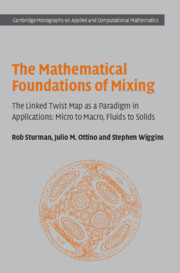 The Mathematical Foundations of Mixing
The Mathematical Foundations of Mixing Book contents
- Frontmatter
- Contents
- Preface
- Acknowledgments
- 1 Mixing: physical issues
- 2 Linked twist maps: definition, construction and the relevance to mixing
- 3 The ergodic hierarchy
- 4 Existence of a horseshoe for the linked twist map
- 5 Hyperbolicity
- 6 The ergodic partition for toral linked twist maps
- 7 Ergodicity and the Bernoulli property for toral linked twist maps
- 8 Linked twist maps on the plane
- 9 Further directions and open problems
- References
- Index
5 - Hyperbolicity
Published online by Cambridge University Press: 03 February 2010
- Frontmatter
- Contents
- Preface
- Acknowledgments
- 1 Mixing: physical issues
- 2 Linked twist maps: definition, construction and the relevance to mixing
- 3 The ergodic hierarchy
- 4 Existence of a horseshoe for the linked twist map
- 5 Hyperbolicity
- 6 The ergodic partition for toral linked twist maps
- 7 Ergodicity and the Bernoulli property for toral linked twist maps
- 8 Linked twist maps on the plane
- 9 Further directions and open problems
- References
- Index
Summary
This chapter contains concepts and results from the field of hyperbolic dynamical systems. We define uniform and nonuniform hyperbolicity, and go on to describe Pesin theory, which creates a bridge between nonuniform hyperbolicity and the ergodic hierarchy.
Introduction
Hyperbolic dynamics, loosely speaking, concerns the study of systems which exhibit both expanding and contracting behaviour. Hyperbolicity is one of the most fundamental aspects of dynamical systems theory, both from the point of view of pure dynamical systems, in which it represents a widely studied and thoroughly understood class of system, and from the point of view of applied dynamical systems, in which it gives one of the simplest models of complex and chaotic dynamics. However the pay-off for this amount of knowledge and (apparent) simplicity is severe. While hyperbolic objects (for example certain fixed points and periodic orbits, and horseshoes, like that constructed in the previous chapter) are common enough occurrences, these are arguably of limited practical importance, as all these objects comprise sets of zero (Lebesgue) measure. There are only a handful of real systems for which the strongest form of hyperbolicity (uniform hyperbolicity) has been shownto exist on a set of positive measure. Typically, uniformly hyperbolic systems tend to be restricted to model systems, such as the Arnold Cat Map (Arnold & Avez (1968)), or idealized mechanical examples, such as the triple linkage of Hunt & Mackay (2003).
Weaker forms of hyperbolicity have been studied in great detail, and powerful results exist linking these to mixing properties, but still any sort of hyperbolicity is not a straightforward property to demonstrate.
- Type
- Chapter
- Information
- The Mathematical Foundations of MixingThe Linked Twist Map as a Paradigm in Applications: Micro to Macro, Fluids to Solids, pp. 126 - 158Publisher: Cambridge University PressPrint publication year: 2006


